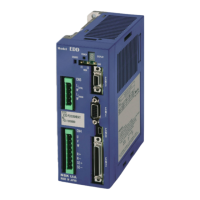6. Operation
— 6-24 —
The following show a typical example of the pulse train command positioning.
Fig 6-16: Signal timing of pulse train command positioning
(1) Activates the input SVON (Servo on) to turn the Motor servo on.
(2) The output SVST (Servo state) closes when the Motor servo is turned on.
Inputted pulses before closing the output SVST won’t be counted.
(3) Input the pulse train. The Motor rotates the amount of value set by the parameters PC (Pulse
command) and CR (Circular resolution).
(4) The input IPOS is forcibly opened when the pulse train command is detected.
When the pulse train input is detected, the state of IPOS is forced to become open.
If the pulse train pauses more than 0.1ms, in-position will be occurred at the timing of (5) in the
diagram above. In this case, increase the parameter IS (In-position stability timer).
(5) A positioning completes when the pulse train input stops and the position error counter clears
the conditions set by parameters IN (In-position threshold) and IS (In-position stability timer).
When the pulse train input is detected, the state of IPOS is forced to become open. If you wish to output to
see if there is the position error or not, use TEU output.
Refer to “8.3.2.1. Position Error: TEU (Position Error, Under) and TEO (Position Error, Over)” for the
output TEU.

